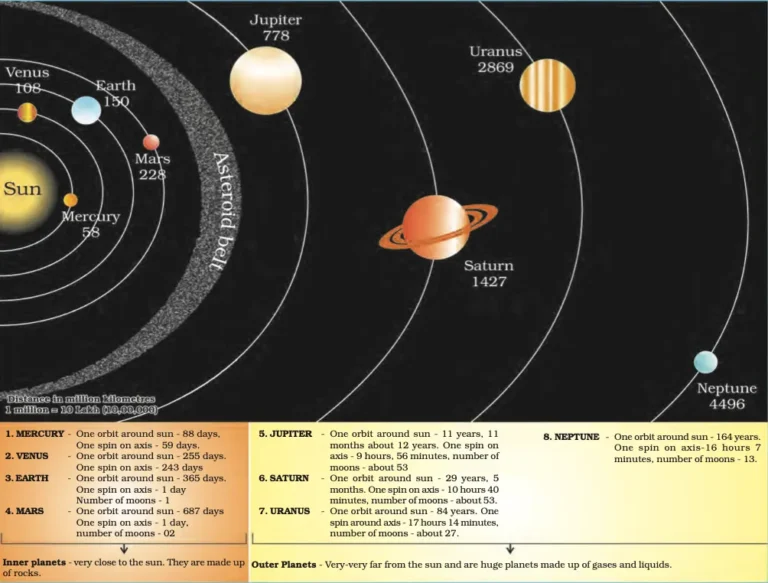Class 7 Geography Chapter 5 Notes – Water
In this post Class 7 Geography Chapter 5 Notes / Water Class 7 Notes we will discuss the Water Cycle, Distribution of Water Bodies, and Ocean Circulation. As water is very important for all living beings so you are expected to have basic knowledge of water and its distribution. Class 7 geography ch 5 water notes are based on NCERT. You can also download the Class 7 Water Notes pdf.
You can also check – Class 7 Geography Notes for all chapters
What is Water Cycle?
The process by which water continually changes its form and circulates between oceans, atmosphere and land is known as the water cycle.
- The sun’s heat causes the evaporation of water into vapour.
- When the water vapour cools down, it condenses and forms clouds.
- From there it may fall on the land or sea in the form of rain, snow or sleet.
The major sources of fresh:- The major sources of fresh water are rivers, ponds, springs and glaciers.
The ocean bodies and the seas contain salty water. The water of the oceans is salty or saline as it contains a large amount of dissolved salts. Most of the salt is sodium chloride or the common table salt that you eat.
Note: Salinity is the amount of salt in grams present in 1000 grams of water. The average salinity of the oceans is 35 parts per thousand.
The dead sea in Israel has a salinity of 340 grams per litre of water. Swimmers can float in it because the increased salt content makes it dense.

Distribution of Water Bodies
Three-fourths of the earth’s surface is covered by water. The following table gives the distribution of water in percentage.

Ocean Circulation
Unlike the calm waters of ponds and lakes, ocean water keeps moving continuously. It is never still. The movements that occur in oceans can be broadly categorised as waves, tides and currents.
Waves
What is Wave?
When the water on the surface of the ocean rises and falls alternately, they are called waves.
Note: Waves are formed when winds scrape across the ocean surface. The stronger the wind blows, the bigger the wave becomes.
How Ocean Wave are formed?
During a storm, the winds blowing at very high speed form huge waves. These may cause tremendous destruction. An earthquake, a volcanic eruption or underwater landslides can shift large amounts of ocean water. As a result, a huge tidal wave called tsunami is formed.
Note: Tsunami is a Japanese word that means “Harbour waves” as the harbours get destroyed whenever there is a tsunami.
Tides
The rhythmic rise and fall of ocean water twice a day is called a tide.
High Tide: It is high tide when water covers much of the shore by rising to its highest level.
Low Tide: It is low tide when water falls to its lowest level and recedes from the shore.
Cause of Tides: The strong gravitational pull exerted by the sun and the moon on the earth’s surface causes the tides. The water of the earth closer to the moon gets pulled under the influence of the moon’s gravitational force and causes high tides.
Spring Tide: During the full moon and new moon days, the sun, the moon and the earth are in the same line and the tides are highest. These tides are called spring tides.
Neap Tides: When the moon is in its first and last quarter, the ocean waters get drawn in diagonally opposite directions by the gravitational pull of the sun and moon resulting in low tides. These tides are called neap tides.

Importance of Tides: High tides help in navigation. They raise the water level close to the shores. This helps the ships to arrive at the harbour more easily. The high tides also help in fishing. Many more fish come closer to the shore during the high tide. This enables fishermen to get a plentiful catch. The rise and fall of water due to tides is being used to generate electricity in some places.
Ocean Currents
Ocean currents are streams of water flowing constantly on the ocean surface in definite directions. The ocean currents may be warm or cold.
Types of Ocean Current- Ocean currents are of two types
1) Warm Ocean Currents, 2) Cold Ocean Currents
- The warm ocean currents originate near the equator and move towards the poles. eg- Gulf Stream
- The cold currents carry water from polar or higher latitudes to tropical or lower latitudes. eg- The Labrador Ocean Current
Importance of Ocean Currents
- The ocean current influence the temperature conditions of the area.
- Warm currents bring about warm temperatures over the land surface.
- The areas where the warm and cold currents meet provide the best fishing grounds in the world. Seas around Japan and the eastern coast of North America are such examples.
- The areas where a warm and cold current meets also experience foggy weather making it difficult for navigation.
We hope you like this post Class 7 Geography Chapter 5 Notes / Water Class 7 Notes. Please share this post to help others.
